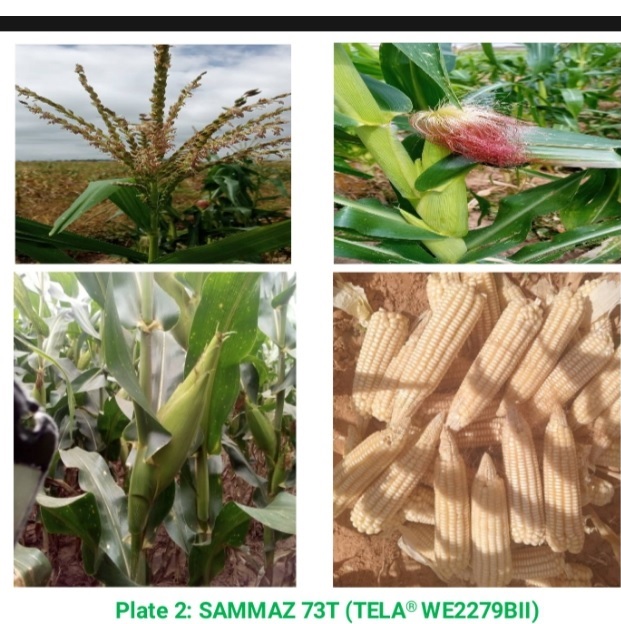
Ahmadu Bello University Zaria
releases four (4) transgenic drought-tolerant and insect-protected (TELA®)
maize varieties to enhance food security in sub-Saharan Africa.
On January 11, 2024, the Institute for
Agricultural Research Samaru at Ahmadu Bello University achieved a significant
milestone as the National Committee on Naming, Registration, and Release of
Crop Varieties, Livestock Breeds/Fisheries granted commercial registration and
released four transgenic maize hybrids known as TELA Maize.
This milestone, announced at the 37th
meeting held at the National Centre for Genetic Resources and Biotechnology
(NACGRAB) in Ibadan, Nigeria, signifies a strategic move towards enhancing
agricultural productivity and sustainability across the region. The TELA Maize
Project, a collaborative effort involving public and private stakeholders, is
spearheaded by the African Agricultural Technology Foundation (AATF) and spans
seven countries in Africa, namely Ethiopia, Kenya, Mozambique, Nigeria, South
Africa, Tanzania, and Uganda. The word ‘TELA’ is derived from the Latin word
TUTELA which means ‘Protection’.
The TELA Maize Project, backed by the Bill
and Melinda Gates Foundation and the United States Agency for International
Development, is dedicated to addressing drought-related concerns in maize
cultivation and countering destructive pests, particularly stemborers and the
fall armyworm. This initiative strategically targets significant threats to
maize production across several African countries. Stemborers and the fall
armyworm pose formidable challenges, potentially leading to substantial yield
reductions and the annual destruction of up to 20 million metric tons of maize
in Africa—enough to sustain 100 million people. In response to these pressing
issues, the TELA Project strategically intervenes by working towards the
commercialization of transgenic maize varieties engineered to resist both
drought and insect infestations. This approach aims to enhance food security in
Sub-Saharan Africa by mitigating the impact of these agricultural threats.
The transgenic technology, encompassing gene
constructs, transformation, recombinant DNA technologies, and proprietary
information, is generously licensed royalty-free by Bayer CropScience LP
(formerly Monsanto Company) to project partners. Notably, seed companies in
Nigeria will be granted license rights to produce and commercialize the
innovative TELA hybrids under their private brands, courtesy of AATF. This
visionary approach enables licensed seed companies to access the technology
without royalty fees, enabling them to offer seeds to farmers at competitive
market prices.
This groundbreaking initiative, championed
by Prof Rabiu Adamu, the Principal Investigator of TELA Maize Nigeria,
introduces four distinct maize hybrids - SAMMAZ 72T, SAMMAZ 73T, SAMMAZ 74T,
and SAMMAZ 75T. These hybrids have been engineered to exhibit superior drought
tolerance, protection against stem borers, and significant resistance to the
fall armyworm. Consequently, smallholder farmers stand to benefit from reduced
expenditures on insecticides, minimized exposure to harmful chemicals, and
improved yields with superior grain quality.
The release of these transgenic maize varieties marks a transformative leap in agricultural technology, promising a more resilient and sustainable future for farmers in sub-Saharan Africa. As the TELA Maize Project gains momentum, it is poised to play a pivotal role in addressing pressing challenges and contributing to the overall advancement of food security in the region.
The profiles of the four maize hybrids tagged SAMMAZ 72T, SAMMAZ 73T, SAMMAZ 74T, and SAMMAZ 75T are as follows:
SAMMAZ 72T
·
Morphological
Characteristics: Short height (150 – 160 cm), deep green leaves and stem
·
Adaptation:
Guinea and Sudan Savannah ecologies
·
Days
to maturity: 100 – 110 days
·
Potential
Yield: 9.4 tonnes/hectare
·
Pest
and disease reaction: Tolerance to maize streak virus, rust, leaf blight,
curvularia leaf spot and resistance to fall armyworm.
·
Outstanding
characteristics: Good standability and high grain yield.
SAMMAZ 73T
·
Morphological
Characteristics: Medium height (170 – 180 cm), deep green leaves and stem
·
Adaptation:
Rain forest and Guinea savannah ecologies
·
Days
to maturity: 100 – 110 days
·
Potential
Yield: 10.4 tonnes/hectare
·
Pest
and disease reaction: Tolerance to maize streak virus, rust, leaf blight,
curvularia leaf spot and resistance to fall armyworm.
·
Outstanding
characteristics: Good standability and high grain yield
SAMMAZ 74T
·
Morphological
Characteristics: Medium height (170 – 180 cm), deep green leaves and stem with
purple coloration.
·
Adaptation:
Guinea and Sudan Savannah ecologies
·
Days
to maturity: 100 – 110 days
·
Potential
Yield: 10.2 tonnes/hectare
·
Pest
and disease reaction: Tolerance to maize streak virus, rust, leaf blight,
curvularia leaf spot, and resistance to fall armyworm.
·
Outstanding
characteristics: Good standability, high grain yield, excellent stay green and
large kernel size.
SAMMAZ 75T
·
Morphological
Characteristics: : Medium height (175 – 185 cm), deep green leaves and stem
with purple coloration.
·
Adaptation:
Guinea and Sudan Savannah ecologies
·
Days
to maturity: 100 – 110 days
·
Potential
Yield: 10.2 tonnes/hectare
·
Pest
and disease reaction: Tolerance to maize streak virus, rust, leaf blight,
curvularia leaf spot, and resistance to fall armyworm.
· Outstanding characteristics: Good standability, high grain yield, excellent drought tolerance.
Comment